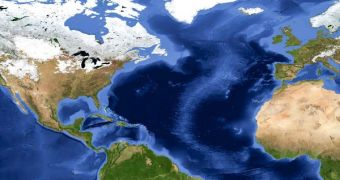About a week ago, the news broke that a new subduction zone is most likely forming close to Spain and Portugal's coastline.
As reported at that time, the formation of this new subduction zone could eventually cause the Atlantic Ocean's seafloor to be pulled into the Earth's mantle.
New information on the topic says that, according to several estimates, it will take some 220 million years before the Atlantic Ocean disappears.
Odds are that the vanishing of the Atlantic Ocean will mark the beginning of a cycle that, over the course of several other million years, will bring the continents closer and closer together.
When this cycle comes to an end, the continents now towering over our planet's oceans would find themselves fused together into a single mass of land, Daily Mail reports.
This new mass of land would not be all that different from Pangea, a supercontinent estimated to have existed about 200 million years ago.
The researchers who documented the formation of this new subduction zone explain that the area that sparked their interested is located at a distance of about 120 miles (193 kilometers) off Portugal's southwest coast.
It is a crack in the Eurasian plate that is made up of six different segments and that covers a distance of 186 miles (300 kilometers).
Once the Atlantic Ocean begins to shrink, specialists expect that North America and Iberia will start heading towards each other, and that at some point in the future, they will even collide.
“Eventually North America and Iberia will be together again, and the collision will give origin to new mountain chains like the Himalaya,” researcher João Duarte reportedly told National Geographic.
This new subduction zone is not yet fully formed. As João Duarte put it, it is in its “embryonic” state.
However, it has already triggered noteworthy earthquake activity. More precisely, it is believed that it can be blamed for Lisbon's 8.7-magnitude earthquake in 1755.
Researchers intend to continue studying it, and are confident that they will soon be able to come forward with more information.

 14 DAY TRIAL //
14 DAY TRIAL //